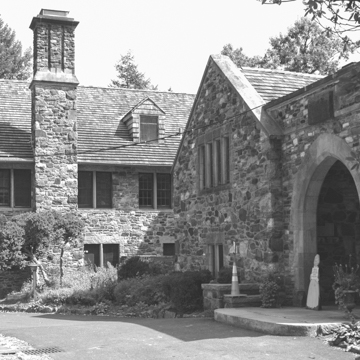A 1789 farmhouse was incorporated by Wilson Eyre Jr. into the immense English Gothic Revival country seat of Walter M. Jeffords, who acquired some two thousand acres in the vicinity of the Rose Tree Hunt. From the front, the house nestles into its site, but its rear wings extend out on great stone terraces that in classic Eyre fashion merged the site with the living spaces. With its great stone chimneys, channeled down their centers in the manner of the houses in the vicinity of George Washington's ancestral Sulgrave Manor in Oxfordshire, England, the house blends Anglophilia and nationalism while representing the landed gentry's lifestyle. In so rural a location
You are here
“Hunting Hill,” Walter Jeffords House
1789; 1915–1916, Eyre and McIlvaine. Ridley Creek State Park
If SAH Archipedia has been useful to you, please consider supporting it.
SAH Archipedia tells the story of the United States through its buildings, landscapes, and cities. This freely available resource empowers the public with authoritative knowledge that deepens their understanding and appreciation of the built environment. But the Society of Architectural Historians, which created SAH Archipedia with University of Virginia Press, needs your support to maintain the high-caliber research, writing, photography, cartography, editing, design, and programming that make SAH Archipedia a trusted online resource available to all who value the history of place, heritage tourism, and learning.


